

  |
Each workstation running SecureLogin has an administration tool.
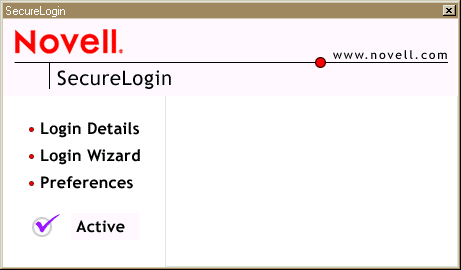
To launch this tool, double-click the SecureLogin icon on the system tray.
You can use this tool to manage users' single sign-on credentials and configure SecureLogin preferences. This tool can only alter the current user's SecureLogin information. To create corporate scripts you must use the NetWare Administrator or ConsoleOneTM snap-ins.
The Login Details option enables you to view, edit, add, or delete login information. The following figure illustrates buttons that enable you to complete these tasks.

To access the Login Details screen, select the Login Details option on the administration tool, or right-click the SecureLogin icon on the system tray > select Login Details.
If you make a mistake while adding, editing, or removing details, click Cancel to close the application without saving any changes.
The platform column is the leftmost list on the Login Details screen. It contains a list of different platforms or applications that SecureLogin is currently authenticating to.
In the following illustration, three platforms are enabled:
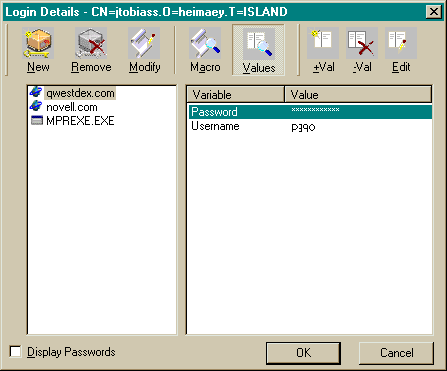
Each listed platform name has an icon next to it. These icons identify the platform type:
Some additional modules (for example, Lotus Notes) might allow for their own specific type.
When you select a platform, information in the Variable and Value columns is updated.
To edit the script for a platform, double-click the platform or click Modify.
The following figure illustrates a script.
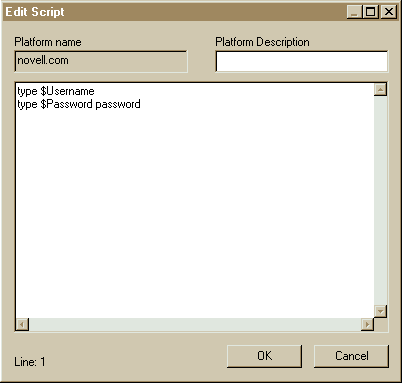
The New button enables you to add a platform or application to the SecureLogin list. SecureLogin then automatically authenticates and logs you in. This option is for administrators and advanced users.
This procedure is not necessary for most applications because it is easier to use the wizards to set up single sign-on for a platform.
Click New.
In the Platform Name box, provide a name for the application.
For Windows Application script types, you must use the application executable name as the platform name. For Internet Page script types, you must specify the URL address as the platform name.
Select a Script Type > click OK.
Enter a script.
As the following figure illustrates, the Variable column usually just contains the password and username for a particular application.

However, in some more complicated applications, there may be other variables too.
This example has two variables, Password and Username. The script for this platform has the following line:
type $Username
The value for this variable is p390. At run time, the value p390 will be substituted with $Username. This substitution allows corporate scripts to work. A corporate script might include type $Username. Depending on who is running the script, an individual username would be substituted.
To edit a value for a variable, double-click it, or select it > click Edit.
To delete a variable and accompanying value, select the variable > click -Val.
For more information on variable substitution, see SecureLogin Script Language.
You can add a new variable to the list of variables of the currently highlighted platform.
Click +Val.
Enter a variable name
Enter a value > click OK.
To remove a variable and accompanying value, select the variable > click -Val.
To delete an application from the platform list, select it > click Remove.
To view SecureLogin macros, click the Macro button, which does the following:
To toggle back to the Variable view, click Values.
By default, the Login Details screen displays passwords as xxxxxxxx. You can view the actual password.
Select the application.
Check the Display Passwords check box.
The Login Wizard generates scripts for Windows and Web applications. You can also use this wizard to run predefined scripts.
At the Novell® SecureLogin tool's main screen, select Login Wizard.
Enter a description, for example, Quicken.
Select Predefined Script > click Next.
Select from the list of predefined applications.
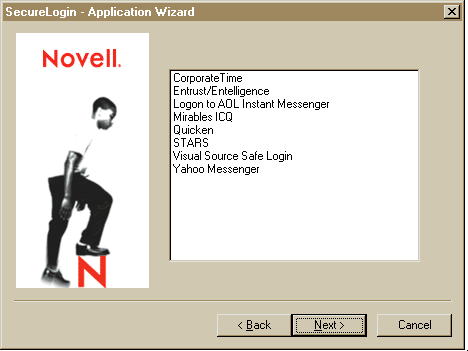
To view the newly added script:
Click Login Details.
Double-click the application listed in the platform column.
At the Novell SecureLogin tool's main screen, select Login Wizard.
Enter a description, for example, Remedy.
Select Windows Application > click Next.
Follow the on-screen prompts.
You drag and drop hand icons into login fields.
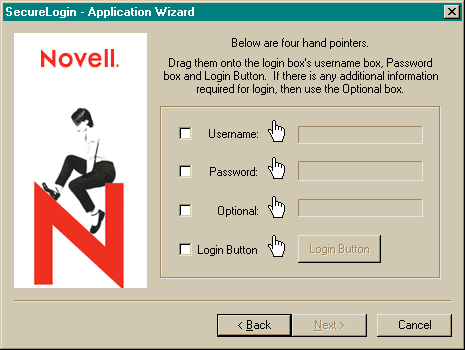
Use the Preferences option to customize the operation of SecureLogin. You can restrict users from accessing the Preferences option.
The following figure illustrates preferences that you can set.
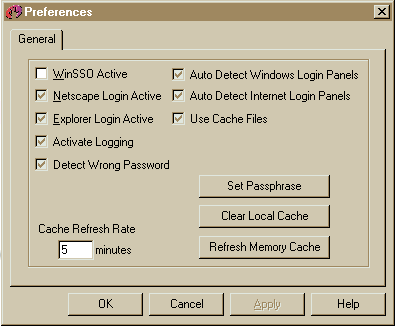
To enable the Windows single sign-on features of SecureLogin, check the WinSSO Active check box. To disable Windows single sign-on, uncheck the check box.
Default: On (checked)
To enable the Netscape single sign-on features of SecureLogin, check the Netscape Login Active check box. To disable Netscape single sign-on, uncheck the check box.
Default: On (checked)
To enable Microsoft Internet Explorer features of SecureLogin, check the Explorer Login Active check box. To disable Internet Explorer single sign-on, uncheck the check box.
Default: On (checked)
To log the details of use to the hard drive, check the Activate Logging check box. However, because this preference is used for debugging and troubleshooting, do not use this option unless Technical Services advises you to. Leave the check box unchecked.
Default: Off (unchecked)
To enable SecureLogin to attempt to detect whether you have given it an incorrect password, check the Detect Wrong Passwords check box. SecureLogin then prompts you to change the password.
Default: On (checked)
The Auto Detect Windows Login Panels setting controls whether the Windows single sign-on component automatically detects Windows login panels. To receive a prompt to run the wizard, check the check box.
Default: On (checked)
The Auto Detect Internet Login Panels setting controls whether the Web single sign-on component automatically detects Web login panels. To receive a prompt to run the wizard, check the check box.
Default: On (checked)
Usernames and passwords are normally stored in a directory on the server, but if the server is unavailable, or if you are using a notebook computer, the cache is used. The cache is password protected and encrypted.
To enable SecureLogin to use cache files, check the Use Cache Files check box.
Default: On (checked)
The cache refresh rate controls the number of minutes that SecureLogin waits between synchronizing the information between eDirectory and the local cache.
Default: 2 (minutes)
The Set Passphrase option enables you to reset your selected passphrase and password combination.
Click Set Passphrase.
Enter the password to your passphrase > click OK.
Enter a new passphrase question and answer.
Confirm the answer > click OK.
To clear the entries held in the local cache, click Clear Local Cache.
To force SecureLogin to immediately synchronize the data between NDS® eDirectory and the local cache, click Refresh Memory Cache.
The Active setting on the administrative tool controls whether the following preferences are enabled:
By default, the Active button is checked. This setting enables the three preferences. To disable these preferences, uncheck the Active button.
  |